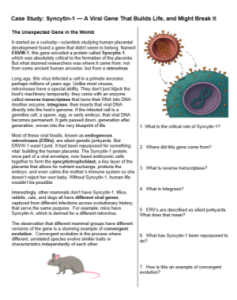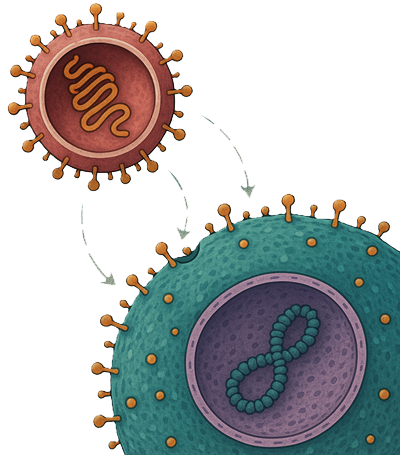
What if we told your students that a gene critical to human pregnancy came from a virus? And what if that same gene, when turned on in the wrong place, might play a role in multiple sclerosis? This is the real and fascinating story behind Syncytin-1, a protein that reveals just how tangled the relationship is between evolution, virology, and human health.
This case study is a perfect way to spark student interest in molecular biology, genetics, evolution, immunology, and neuroscience—all in one lesson.
🧪 What’s the Case Study About?
The Syncytin-1 case study tells the story of ERVW-1, a gene in our genome that originated from a retrovirus millions of years ago. Normally, viral DNA doesn’t stick around—but when it infects a germline cell, it can become a permanent part of our heredity. That’s what happened with ERVW-1. Instead of causing disease, it was repurposed to help build the placenta, allowing humans (and other mammals) to carry pregnancies to term.
But the story takes a darker turn. In people with multiple sclerosis (MS), Syncytin-1 becomes abnormally expressed in brain tissue, where it may trigger inflammation and damage the myelin sheath that insulates neurons. Even more intriguing? A common virus—Epstein-Barr virus (EBV)—may be the key to reactivating this ancient gene.
This dual role makes Syncytin-1 a powerful example of how evolutionary biology and modern medicine intersect.
🧠 Why This Case Study Works in the Classroom
This isn’t just a cool story—it’s a high-impact teaching tool that helps students:

- Understand how retroviruses can become part of our genome
- Explore the concept of exaptation—genes taking on new roles
- Connect gene regulation to real-world diseases
- Investigate the viral roots of autoimmune disorders like multiple sclerosis
- Think critically about the complex role viruses play in evolution and health
It’s also a great entry point for discussions about how science changes over time, as new research (like the EBV–MS connection) continues to evolve.
This free case study includes:
- A narrative-style reading passage written for high school or early college students
- A free-response question with a 4-level rubric (ideal for assessments)
- A vocabulary list organized by topic
- Optional visuals (e.g., neuron diagram, placental structure)
- Discussion questions to encourage synthesis and debate
You can use this as a stand-alone lesson, an extension in a genetics or immune system unit, or as a bridge between molecular biology and human health topics.
Related Activities
Case Study – Measles, Immunity, and Vaccines – explore how a virus affects the immune system and how vaccination works
Exploring the Immune System with Alpha – Gal Syndrome – a bite from a tick causes a mysterious meat allergy (case study).
Case Study- Sleepless, Not Tired – how a change in a gene results in humans needed less sleep
Snake Detection Hypothesis – study showing how humans may have evolved the ability to detect snakes
How Can Mutations Show Convergent Evolution – explore DNA mutations in aquatic mammals; analyze a phylogenetic tree

